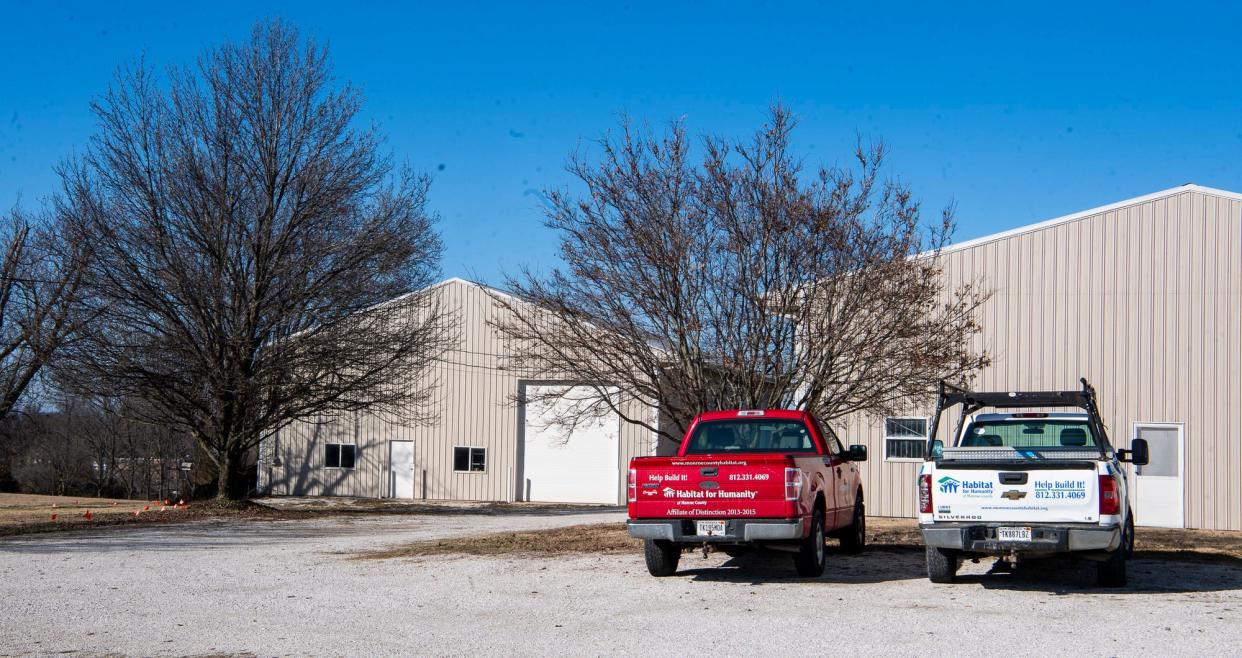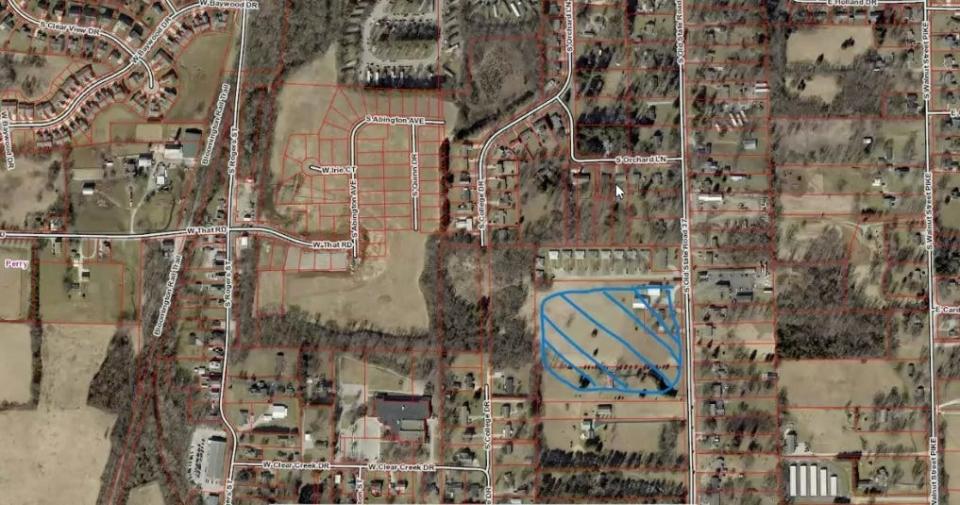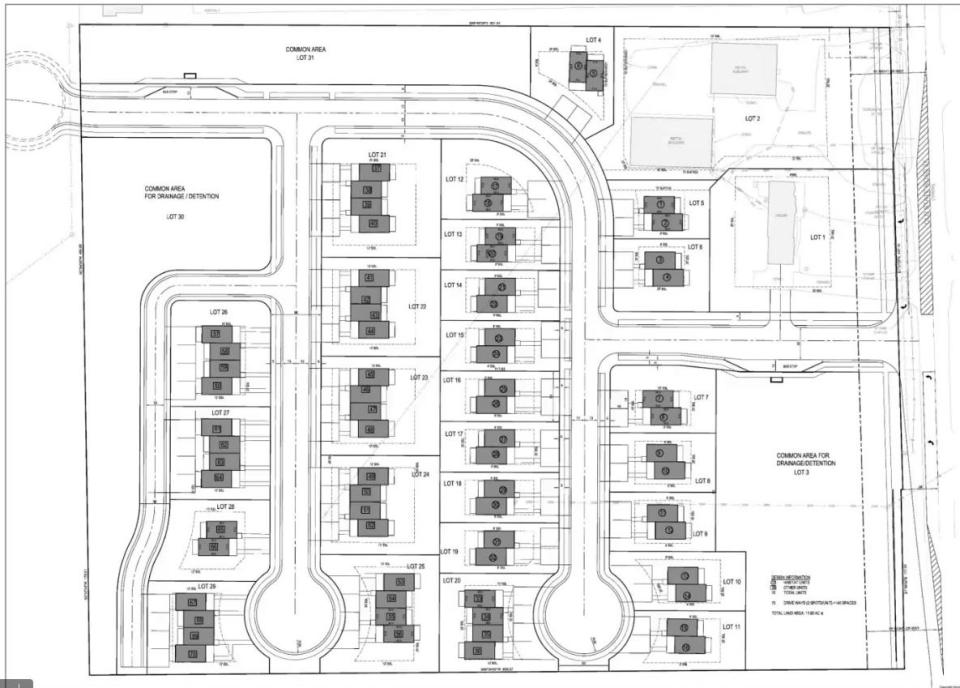How Monroe County plans to use ARPA funds to help build 70 housing units

County leaders plan to use $3.5 million in pandemic relief dollars to spur development of a neighborhood near Clear Creek Elementary School.
County Attorney Jeff Cockerill said in public meetings last week the county is targeting an 11-acre property at 4810 S. Old Ind. 37. He said the county plans to work with the owner, developer Kenneth Blackwell, and Habitat for Humanity, to build 70 homes.
“This is really exciting,” Monroe County Commissioner Julie Thomas said when Cockerill provided an update on the project.
All of Habitat’s 32 units would be paired townhomes, except two that may be single-family homes, said Wendi Goodlett, president and CEO of Habitat for Humanity of Monroe County. Habitat clients qualify for homes based on their income, among other aspects.

Cockerill said Blackwell would build 38 paired townhomes and quadplexes, which would be sold at market rates. Blackwell could not be reached Thursday or Friday, but Cockerill said Blackwell hoped to sell each of the units for about $300,000.
Cockerill said the county would use $3.5 million in American Rescue Plan Act funds for infrastructure, including roads, sidewalks and sewer connections, which would help reduce costs for Habitat and Blackwell and therefore lower the prices homeowners would have to pay.
Goodlet said via email, “Any gift of land, infrastructure, materials or labor lowers our cost to provide homeownership opportunities and increases the number of families/individuals we can serve."

Cockerill said the county also planned to use the ARPA funds to rehab an existing building on the property to turn it into a child care center, which would be operated by a private or nonprofit provider.
Commissioner Penny Githens said last week the project would help address the housing shortage as well as the child care shortage, with possible opportunities for neighborhood residents to work at the center.
Cockerill emphasized many of the project details would still have to be worked out, including a possible tax increment financing district that might help pay for some nearby infrastructure, including a sidewalk or multi-use path along Old Ind. 37 to or close to the Kroger grocery store about a half mile north of the development, near East Rohrer Road. TIF districts capture tax dollars from new developments in a small geographic area and require those dollars be spent to benefit that area.
Cockerill said the county also liked the location because of its proximity to Clear Creek Elementary School and the Clear Creek Trail, both to the southwest.
The county attorney said county leaders are working with the planning department. The project would go through the plan commission and require approval from commissioners.
Policy denying sewer extension outside city limits still in place
Cockerill said questions about sewer hookups also still have to be answered.
Bloomington City Utilities, under former Mayor John Hamilton, stopped extending sewer service beyond city limits so long as annexation is pending. Formerly, CBU extended sewer service to developing areas near the city to foster growth. The cost of such extensions are borne by the builders, who passed the additional cost to the eventual homeowners.
That practice allowed builders to hook up homes to the municipal sewer and to forego septic systems, which require more land, which means fewer homes. The city, meanwhile, could encourage the construction of residential dwellings and at the same time reduce the number of septic systems, which are prone to failure and can contaminate local waterways.
The city extended the sewer pipes with the understanding the properties would eventually become part of the city through annexation. To ensure the homeowners couldn’t change their minds and oppose a future annexation, the city had them sign documents, called remonstrance waivers, that prohibit the property owners from opposing a future annexation.
But, the city, under Hamilton's leadership, said that arrangement — a sewer extension for a remonstrance waiver — is no longer workable, because in 2019 the state passed a law that invalidates waivers older than 15 years. In other words, unless the city annexes properties within 15 years of extending sewer service, the property owners, in the city’s view, get to renege on the deal, remain outside city limits and dodge paying city taxes.
“Therefore most development outside the City will need to move forward with a wastewater plan that does not involve the City's Utilities Department,” CBU said in an email at the time.
Angela Van Rooy, spokeswoman for Mayor Kerry Thomson, said via email last week that the no-sewer-extensions-pending-annexation policy begun under Hamilton is continuing.
"Sewer extensions are not being made outside the city while annexation is pending," she said.
Cockerill said the county could consider supplying the planned neighborhood with a "package plant," which, according to the U.S. Environmental Protection Agency, are "pre-manufactured treatment facilities used to treat wastewater in small communities or on individual properties."
"In general," the agency said, "package treatment plants are applicable for areas with a limited number of people and small wastewater flows. They are most often used in remote locations such as trailer parks, highway rest areas, and rural areas."
The agency said in a fact sheet the advantages of such plants include that they are easy to operate and odor free, though disadvantages include that they require more energy and a larger amount of space and tankage than other "higher rate" processes.
How to qualify for a Habitat for Humanity home
Goodlet said via email that Habitat serves clients whose income is between 35% and 80% of the area median income, which changes with household size. For 2023, for a household of three, Habitat guidelines required an income of at least $28,455 but no more than $65,050. You can find more details at this link: tinyurl.com/bdadmsey.
Habitat homeowners can, after fulfilling the terms of the mortgage (15-30 years), sell the house and benefit from the increased home value. However, Goodlet said 85% of the homes built by the organization in Monroe County are still owned by a Habitat family, “even those who have paid off their mortgages."
Habitat’s all-in cost per house is about $160,000 in its Osage Place neighborhood, including about $107,000 in materials and subcontractor labor. Volunteer labor saves the organization about $50,000 per house. The houses appraise at about $235,000.
Infrastructure costs at Habitat’s Osage Place neighborhood came in at about $80,000 per lot, Goodlet said. Given the county’s investment, Habitat would save those costs in the Clear Creek development. Habitat also would not be paying for the land in the planned neighborhood, Goodlet said.
Boris Ladwig can be reached at bladwig@heraldt.com.
This article originally appeared on The Herald-Times: Monroe County plans housing development near Clear Creek Elementary

